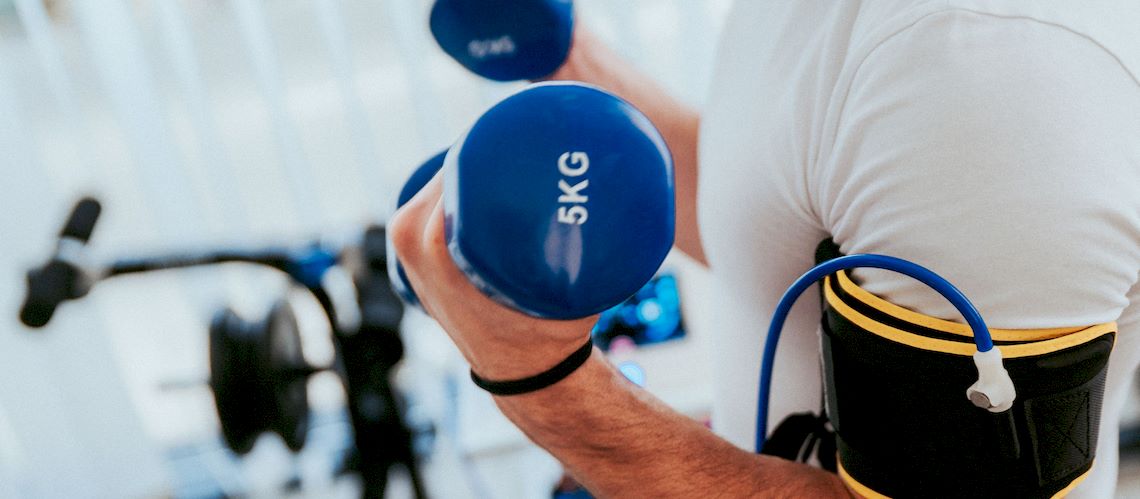Blood Flow Restriction (BFR) training is an innovative exercise modality that involves the application of external pressure to restrict venous blood flow from a working muscle while maintaining arterial inflow. This technique, often used in both clinical rehabilitation settings and athletic performance programs, allows individuals to achieve significant muscular adaptations with low-intensity exercise. Within the Self Matrix framework, BFR training aligns with holistic approaches to health, integrating body, mind, and spirit by facilitating injury rehabilitation, maximizing athletic performance, and enhancing overall well-being.
Definition
BFR training involves the use of specialized cuffs or bands to restrict blood flow to the limbs during exercise. This partial occlusion is intended to reduce venous return while allowing arterial blood flow, thereby creating a hypoxic environment within the muscle. The combination of low-intensity exercise and restricted blood flow leads to muscle hypertrophy, strength gains, and increased endurance, typically achieved only with high-intensity training. The efficacy of BFR training has been well-documented in peer-reviewed studies (Loenneke et al., 2012).
History and Origins
BFR training originated in Japan in the 1960s, developed by Dr. Yoshiaki Sato under the name “Kaatsu training.” Over the decades, it has gained popularity worldwide, particularly in the fields of physical therapy, sports rehabilitation, and athletic training. Its growth in popularity is due to a substantial body of research validating its effectiveness in promoting muscle hypertrophy and strength while minimizing the mechanical load on joints, making it a valuable tool for injury rehabilitation and performance enhancement (Sato, 2005).
Principles and Concepts
- Hypoxic Environment: BFR training creates a localized hypoxic (low oxygen) environment in the muscle, which triggers an anabolic response leading to muscle hypertrophy even at low loads. This response is due to the increased production of growth factors such as IGF-1 and reduced myostatin levels, as evidenced in clinical studies (Pearson & Hussain, 2015).
- Metabolic Stress and Muscle Adaptation: The metabolic stress induced by BFR is a potent stimulus for muscle adaptation, increasing the recruitment of fast-twitch muscle fibers that are typically activated during high-intensity exercise (Loenneke et al., 2011).
- Injury Rehabilitation: BFR allows for strength gains and hypertrophy with lower exercise loads, reducing strain on injured tissues. This makes it particularly effective for patients recovering from musculoskeletal injuries (Hughes et al., 2017).
Benefits
BFR training offers numerous benefits, including:
- Muscle Hypertrophy and Strength Gains: Studies have demonstrated that BFR training can lead to significant muscle growth and strength increases, comparable to high-intensity resistance training, but at much lower loads (Slysz et al., 2016).
- Injury Rehabilitation: BFR is highly effective in rehabilitation settings, allowing patients to regain muscle strength and mass without exposing them to high mechanical loads, thus preventing further injury (Hughes et al., 2017).
- Improved Cardiovascular Health: Research indicates that BFR training can improve endothelial function and increase vascular compliance, contributing to better overall cardiovascular health (Patterson et al., 2019).
- Increased Endurance and Fatigue Resistance: BFR training has been shown to enhance muscular endurance and resistance to fatigue, making it beneficial for athletes looking to improve performance (Laurentino et al., 2012).
- Reduced Recovery Time: The low-intensity nature of BFR training reduces the recovery time needed between sessions, allowing for more frequent training without the risk of overtraining (Takarada et al., 2000).
Applications
BFR training can be applied in various contexts, including:
- Rehabilitation from Musculoskeletal Injuries: BFR is used in clinical settings to help patients recover from surgeries or injuries such as ACL reconstruction or rotator cuff tears, where traditional high-load resistance training would be contraindicated (Hughes et al., 2017).
- Maximizing Athletic Performance: Athletes use BFR to increase muscle strength, hypertrophy, and endurance while minimizing the risk of injury associated with high-load training (Slysz et al., 2016).
- Preventing Muscle Atrophy in Elderly Populations: BFR is particularly beneficial for older adults at risk of sarcopenia, as it promotes muscle growth without the need for heavy resistance exercises that may be difficult or unsafe for this population (Patterson et al., 2019).
Scientific Evidence
The effectiveness of BFR training is supported by a growing body of research:
- Muscle Hypertrophy: A meta-analysis by Slysz et al. (2016) concluded that BFR training is highly effective in promoting muscle hypertrophy across various populations, including healthy individuals, athletes, and patients undergoing rehabilitation.
- Injury Rehabilitation: Hughes et al. (2017) demonstrated that BFR training effectively promotes muscle strength and hypertrophy in patients recovering from ACL reconstruction, significantly improving recovery outcomes without compromising joint integrity.
- Cardiovascular Health: Patterson et al. (2019) found that BFR training positively impacts vascular health, with improvements in endothelial function and arterial compliance, suggesting benefits beyond just muscle growth.
How to Get Started
- Select Appropriate Equipment: Begin by choosing the right BFR cuffs or bands. It is crucial to use equipment designed for BFR to ensure proper occlusion and safety.
- Determine Intensity and Load: Start with low-intensity exercises (20-30% of 1RM) while applying BFR. Gradually adjust the pressure to create the desired level of venous occlusion while maintaining arterial flow (Loenneke et al., 2012).
- Monitor Safety and Effectiveness: Pay close attention to how your body responds to BFR training. Ensure that the pressure used does not cause excessive discomfort or numbness and adjust as needed (Sato, 2005).
- Consistency is Key: Regular BFR training sessions, combined with proper nutrition and recovery, are essential for maximizing benefits. Incorporate BFR into your existing training routine, whether for rehabilitation or performance enhancement (Hughes et al., 2017).
Case Studies or Testimonials
Numerous athletes and patients have reported significant improvements in strength, muscle size, and recovery times with BFR training. For example, a case study by Laurentino et al. (2012) highlighted a professional athlete who used BFR training during post-injury rehabilitation and achieved faster recovery and return to peak performance than anticipated. Similarly, elderly patients have experienced reduced muscle loss and improved functional outcomes with regular BFR sessions (Patterson et al., 2019).
Conclusion
Blood Flow Restriction (BFR) training is a versatile and effective method for enhancing muscle hypertrophy, strength, and overall physical health while minimizing the risks associated with high-intensity exercise. Within the Self Matrix framework, BFR training supports holistic well-being by facilitating injury rehabilitation, maximizing athletic performance, and promoting cardiovascular health. As research continues to expand, BFR training’s role in health optimization will likely become even more prominent, offering new avenues for improving quality of life across various populations.
References
- Hughes, L., Paton, B., Rosenblatt, B., Gissane, C., & Patterson, S. D. (2017). Blood Flow Restriction Training in Rehabilitation Following Anterior Cruciate Ligament Reconstruction: A Randomized Controlled Trial. Frontiers in Physiology, 8, 938.
- Laurentino, G., Ugrinowitsch, C., Aihara, A. Y., Fernandes, A. R., Parcell, A. C., Ricard, M., & Tricoli, V. (2012). Effects of Strength Training and Vascular Occlusion. International Journal of Sports Medicine, 33(8), 664-669.
- Loenneke, J. P., Fahs, C. A., Wilson, J. M., & Bemben, M. G. (2011). Blood Flow Restriction: The Metabolic Hypothesis. Medical Hypotheses, 77(3), 570-572.
- Loenneke, J. P., Wilson, J. M., Wilson, G. J., Pujol, T. J., & Bemben, M. G. (2012). Potential Safety Issues with Blood Flow Restriction Training. Scandinavian Journal of Medicine & Science in Sports, 22(5), 510-518.
- Patterson, S. D., Hughes, L., Warmington, S., Burr, J., Scott, B. R., Owens, J., & Madarame, H. (2019). Blood Flow Restriction Exercise: Considerations of Methodology, Application, and Safety. Frontiers in Physiology, 10, 533.
- Pearson, S. J., & Hussain, S. R. (2015). A Review on the Mechanisms of Blood-Flow Restriction Resistance Training-Induced Muscle Hypertrophy. Sports Medicine, 45(2), 187-200.
- Sato, Y. (2005). The History and Future of KAATSU Training. International Journal of KAATSU Training Research, 1(1), 1-5.
- Slysz, J., Stultz, J., & Burr, J. F. (2016). The Efficacy of Blood Flow Restricted Exercise: A Systematic Review & Meta-Analysis. Journal of Science and Medicine in Sport, 19(8), 669-675.
- Takarada, Y., Takazawa, H., & Ishii, N. (2000). Applications of Vascular Occlusion diminish disuse atrophy of knee extensor muscles. Medicine and Science in Sports and Exercise, 32(12), 2035-2039.




